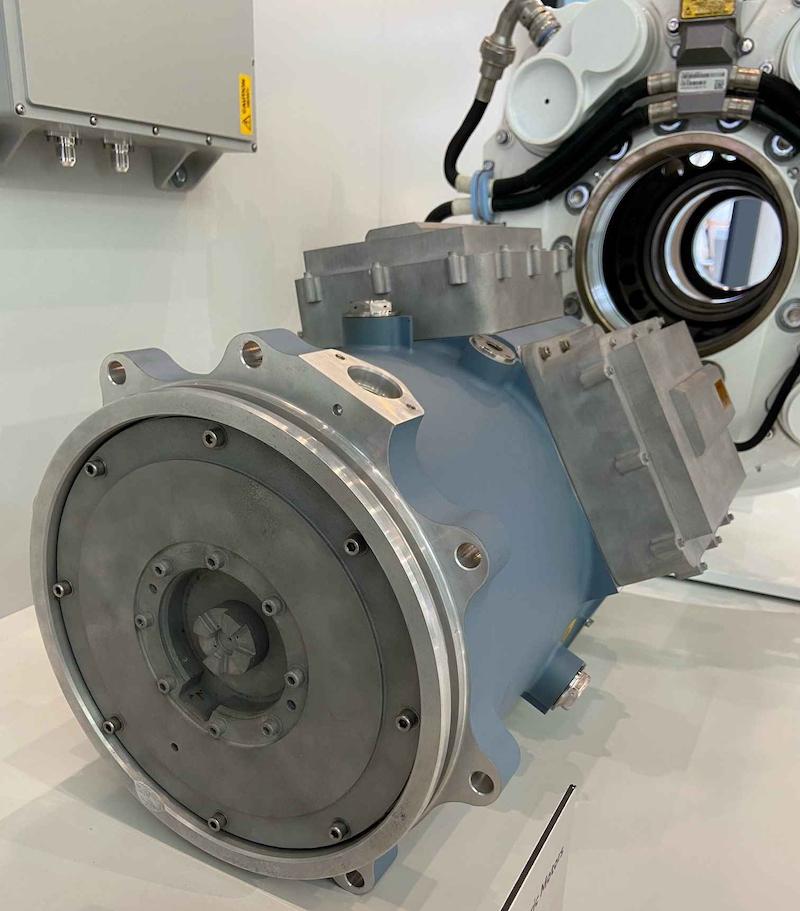
The 1-megawatt motor and motor controller for the flight demonstrator have been sent from Collins’ Solihull facility to Pratt & Whitney Canada’s site in Longueuil, Quebec, where they are undergoing ground tests.
FARNBOROUGH—RTX’s strategic push toward more sustainable hybrid-electric aviation is accelerating with key advances in testing and development of motor, motor-generator and control technologies for future single-aisle, regional and rotary-wing aircraft.
For larger aircraft, the immediate focus is on the Collins Aerospace-built 1-megawatt electric motor, versions of which are under test for RTX’s regional hybrid-electric propulsion flight demonstrator, as well as for Europe’s Clean Aviation Sustainable Water-Injecting Turbofan Comprising Hybrid-Electrics (Switch) engine research program.
The 1-megawatt motor and motor controller for the flight demonstrator—a modified De Havilland Canada Dash 8 turboprop—have been sent from Collins’ Solihull, England, facility to Pratt & Whitney Canada’s site in Longueuil, Quebec, where they are undergoing ground tests as part of the combined propulsion system. Motor loading tests have also begun in Solihull on the first 1-megawatt motor for the Switch program, which combines the MTU-developed water-enhanced turbofan (WET) concept with a hybrid-electric architecture in a Pratt & Whitney PW1100G geared turbofan.
Following these initial ground tests, the Switch unit will be shipped later this year to RTX’s recently developed Grid test facility in Rockford, Illinois, for a full-up power evaluation. The core of the Dash 8 demonstrator and Switch motors are alike, both based on the same radial-flux permanent magnet architecture.
As a result, “a lot of the lessons learned that we're getting from the ground testing on the regional demonstrator, we're applying that to the Switch demonstrator, as well,” says Zubair Baig, senior technical fellow for Electrical Systems at Pratt & Whitney.
The regional demonstrator motor will be combined with a 1-megawatt thermal engine optimized for cruise performance and developed by Pratt & Whitney, as part of a hybrid-electric propulsion system that aims to show up to a 30% improvement in fuel efficiency and carbon dioxide emissions compared to the most advanced current regional turboprops. De Havilland Canada is providing engineering support to modify the aircraft, replacing one of its two P&WC PW120-class turboprops with a 2-megawatt parallel hybrid-electric powertrain. As well as the thermal engine and Collins electric drive, the system incorporates a battery system supplied by Swiss startup H55.
Collins Aerospace is supplying two motor generators for Switch, the hybrid-electric element of which will be initially tested separately from the WET cycle in a modified PW1100G. Both are identical 1-megawatt machines, but the unit connected to the high-pressure spool is derated to 500 kW, while the motor generator attached to the aft of the low-pressure shaft is rated to 1-megawatt. In an operational version RTX says the electric system will be used for taxiing and to boost power for takeoff, as well as other transient phases.
“When we talk about the regional space, in particular, we're looking at a system with 50% hybridization for takeoff and climb, and right sizing the engine for cruise,” Baig says. “Today, we are in the process of working through ground tests and getting lessons learned for developing the systems.”
For the single-aisle applications targeted under the Switch effort, RTX is studying a much smaller level of hybridization in the order of 5%, Baig says. “We want to take advantage of hybridization in a manner where we can address the key weaknesses of today's engines. Today’s single-aisle engines are highly efficient and designed for cruising. But when we look at the off-design points, there are gaps and efficiency losses in areas like idle conditions, acceleration cases and takeoff. So we want to maximize hybridization to boost efficiencies in those segments to get greater returns,” he adds.
